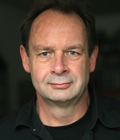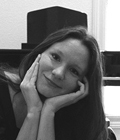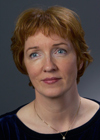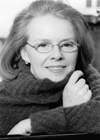
|
Jónas Tómasson studied at the Reykjavík College of Music,
where he was taught composition by Jón Þórarinsson and Þorkell
Sigurbjörnsson. He pursued further studies at the Sweelinck Music Conservatory in
Amsterdam under Ton de Leeuw, Léon Orthel , Jos Kunst and others from 1969 to 1972.
At that time Amsterdam was attracting young artists from all over the world, among them a
group of avant-garde Icelandic visual artists who founded the conceptual art group
SÚM (Young Artists' Society). Jónas soon became an active member of
SÚM, and his music was deeply influenced by their ideology.
Returning to Iceland in 1973, Jónas settled in
Ísafjörður in the West Fjords, where he has lived since.
He has played a prominent part in various fields of musical life there, as a teacher of
flute and theoretical subjects at the Ísafjörður Music School, a
flautist and choir conductor; and for years he has supervised concert programmes
for the Ísafjörður Music Society. Composition remained his primary
vocation, however, and in recent years it has been his full-time occupation.
Jónas is a prolific composer, whose works are varied and diverse.
His compositions include a number of symphonic works, and in recent years he has
written eight Sinfoniettas exploring the sound world of the symphonic orchestra
with different instrumentations. He has also composed several concertos, e.g.
for organ, viola, piano, two pianos and orchestra. Choral works, sacred and
secular, are a large part of his oeuvre, for instance Missa Tibi Laus, A
Lucas Oratorio, Missa Brevis and Songs to the Earth.
Jónas has composed many chamber works for diverse and often innovative
combinations of instruments, as well as solo works for instruments or voice,
often at the special request of the artists.
Many of Iceland's leading musicians have performed Jónas' works:
the Iceland Symphony Orchestra has played many of his symphonic works and concertos,
and the Reykjavík Chamber Orchestra, the Caput ensemble, the Ýmir
ensemble, the Hallgrímskirkja Motet Choir and many smaller musical groups and
soloists have had his works in their repertoire and performed them around the world.
Recordings have been made of many of his works, which have been broadcast
on radio and issued on CDs. The Icelandic Music Centre released a CD of his music,
Portrait, and his Dýrð Krists (The Glory of Christ) for
solo organ was issued on a CD of the same name.
|

|
Herdís Anna Jónasdóttir studied singing in the
Ísafjörður Music School in North-West Iceland, the Iceland Academy
of the Arts in Reykjavík and the Hanns Eisler Academy of Music in Berlin. She
has taken part in several opera productions in Iceland, Germany and Switzerland.
Her operatic roles include Adele in The Bat, Zerlina in Don
Giovanni, The Queen of Schemacha in The Golden Cockerel,
Mabel in the Pirates of Penzance, Sophie in Werther,
Nannetta in Falstaff, Oscar in A Masked Ball and Musetta
in La Bohème.
Herdís Anna has also been very active on the concert stage,
performing at the Carl Orff Festival, with the Reykjavík Chamber Orchestra,
the Saarland State Orchestra and the Iceland Symphony Orchestra. Since the autumn
of 2013, Herdís Anna has been engaged as a soloist at the Saarland
State Theatre in Saarbrücken, Germany and recently she was elected the
Singer of the Year by the opera's Sponsor Club. |

|
Þórunn Arna Kristjánsdóttir started her
musical education at the Ísafjörður Music School and continued at
the Iceland Academy of the Arts in Reykjavík where she received her B.Mus.
degree in singing. Subsequently she started studying at the drama department of
the same Academy, finishing her degree in 2010. That year she was employed as an
actor at the National Theatre and appeared in plays such as Les Miserables,
Macbeth and the Little Prince. For her lead role in the play Karma for Birds,
she was nominated to the Gríma Award in 2013. In 2014, she moved over to the
Reykjavík City Theatre, performing in works such as Billy Elliot and, most
recently, in Mamma Mia.
Þórunn Arna has appeared in television programs in
Iceland, and participated in various theater-related projects at home and abroad.
At the Icelandic Opera the has sung the title role of the Little Girl with the
Matches and Flora in Benjamin Britten's The Turn of the Screw. |

|
Hlíf Sigurjónsdóttir furthered her violin
studies at the Universities of Indiana and Toronto with Franco Gulli and Lorand
Fenyves, and the Banff School of Fine Arts. Later she took lessons with Gerald Beal
in New York. She has been fortunate enough to work with many of the leading
musicians of the twentieth century, including William Primrose, Janos Starker,
Rucciero Ricci, Igor Oistrach, György Sebök and the members of the
Hungarian quartet.
Hlíf has given numerous concerts both as a soloist and with
various ensembles and orchestras. A critically acclaimed 2-CD set of her playing
the Sonatas and Partitas for solo violin by J.S. Bach has been highly praised,
as well as her most recent disk, DIALOGUS, with solo violin works,
all of which were written for her. |

|
Leon van Mil studied music at the Sweelinck Conservatory in
Amsterdam, graduating as an 'Improvising Musician', with the baritone saxophone as
his main instrument. Since then Leon has been very active as a saxophone player
in various musical styles with the emphasis on jazz. He is a member of the dance
band Zoot, the jazz quartet Beaugard and the pop group Vanzanden and is the
conductor of a Big Band in Amsterdam. Leon has released several CDs with his
saxophone quartet Saxo Panico, including Stabat Mater by Pergolesi. He has
taken part in concert tours to China, Thailand and all over Europe,
including Iceland.
Besides playing, Leon teaches the saxophone and leads the
Jazz Academy in the Amsterdam Music School. |

|
Educated in Hannover and Münster in Germany and later in Boston,
Tinna Þorsteinsdóttir plays every style of the
piano repertoire. She has a wide range of experience with contemporary music
and has been active as a performance artist, as well as a pianist and an
improviser. Her creative output includes making sound-scapes, playing prepared
and toy pianos and collaborating with a variety of other art forms.
Tinna has premiered around 70 piano works specially written for her
in recent years and has also performed at a wide variety of special events
including the World Expo 2010 in Shanghai and the Venice Biennale in 2011.
Tinna's solo CD Granit Games with Icelandic piano music was released
in 2007. She is one of the curators for the artist collective Peripheriberry
and of the Cycle Music and Art Festival. Tinna was awarded the DV Culture
Prize in Iceland in 2013. |

|
Sólveig Anna Jónsdóttir studied the piano
at the Music Schools of Ísafjörður and Akureyri, the Reykjavík
College of Music and the University of Houston in Texas. Among her teachers were
Ragnar H. Ragnar, Philip Jenkins, Halldór Haraldsson and Nancy Weems.
Sólveig Anna also has extensive experience as a piano teacher and an
accompanist. She is currently the assistant principal of the Garðabær
Music School.
Sólveig Anna has worked with solo singers, choirs, soloists
and chamber orchestras and has also performed in Iceland and abroad. |

|
Anna Áslaug Ragnarsdóttir studied music at the music
schools in Ísafjörður and Reykjavík and later in London and
Munich. She has been active as a pianist on the concert stage in Europe, North
America and Japan. She has given a great number of solo recitals in Iceland,
e.g. for the Dark Music Days, the Tíbrá Concert Series, LSÓ
Summer Concerts, the music societies in Reykjavík, Akureyri and
Ísafjörður. On several occasions she has been a soloist with the
Iceland Symphony Orchestra. Anna Áslaug has recorded for radio and
television and the Iceland Music Information Centre has released a record of her
playing Icelandic contemporary piano music.
In recent years Anna Áslaug has been increasingly active
performing chamber music and as an accompanist with singers. Anna Áslaug
resides in Munich and Reykjavík. |








